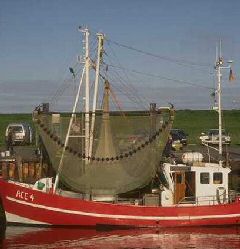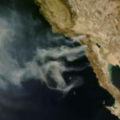
A new study from the Scripps Institution of Oceanography illustrates how global warming caused by greenhouse gases can quickly disrupt ocean processes and lead to drastic climatic and biological changes around the world. The researchers say that although the events unfolded millions of years ago, the findings provide clues that may help us better understand the long-term impacts of today’s human-influenced climate warming.
The study, published in Nature, examined the chemical makeup of tiny ancient sea creatures at various locations around the world. The researchers concentrated on a four- to seven-degree warming period that occurred some 55 million years ago during the closing stages of the Paleocene and the beginning of the Eocene eras.
The data set constructed uncovered a monumental reversal in the circulation of deep-ocean patterns around the world. The researchers concluded that it was triggered by global warming the world was experiencing at that time.
“The Earth is a system that can change very rapidly. Fifty-five million years ago, when the Earth was in a period of global warmth, ocean currents rapidly changed direction and this change did not reverse to original conditions for about 20,000 years,” said researcher Flavia Nunes. “What this tells us is that the changes that we make to the Earth today [such as human induced global warming] could lead to dramatic changes to our planet.”
Nunes and co-researcher Richard Norris analyzed carbon isotopes from the shells of single-celled animals called foraminifera. These organisms exist in a variety of marine environments in vast numbers. “It’s really interesting how a tiny little shell from a sea creature living millions of years ago can tell us so much about past ocean conditions,” said Nunes. “We can tell approximately what the temperature was at the bottom of the ocean. We also have an approximate measure of the nutrient content of the water the creature lived in. And, when we have information from several locations, we can tell the direction of ocean currents.”
The researchers analyzed foraminifera called Nuttalides truempyi from 14 sites around the world in deep-sea sediment cores maintained by the Integrated Ocean Drilling Program. The isotopes were used as nutrient “tracers” to reconstruct changes in deep-ocean circulation through the PETM period. Nutrient levels tell the researchers how long a sample has been near or isolated from the sea surface, giving them a way to track the flow path of deep sea currents.
The study found that deep-ocean circulation abruptly switched from “overturning” – a conveyor belt-like process in which cold and salty water exchanges with warm surface water – in the Southern Hemisphere, where it virtually shut down, and became active in the Northern Hemisphere. The researchers believe this shift drove unusually warm water to the deep sea, likely releasing stores of methane gas that further accelerated the warming process.
The researchers explained that overturning is a fundamental component of the global climatic system that we understand today. Overturning in the modern North Atlantic Ocean is a primary means of drawing heat into the far north Atlantic and keeping temperatures in Europe relatively warmer than conditions in Canada.
The researchers note that modern carbon dioxide input from fossil fuel sources is approaching the same levels estimated for the PETM period, which raises concerns about future climate and changes in ocean circulation. Thus they say the Paleocene/Eocene example suggests that human-produced changes may have lasting effects not only in global climate, but in deep ocean circulation as well. Overturning is very sensitive to surface ocean temperatures and surface ocean salinity,” said Norris. “The case described in this paper may be one of our best examples of global warming triggered by the massive release of greenhouse gases and therefore it gives us a perspective on what the long-term impact is likely to be of today’s greenhouse warming.”


















Comments are closed.